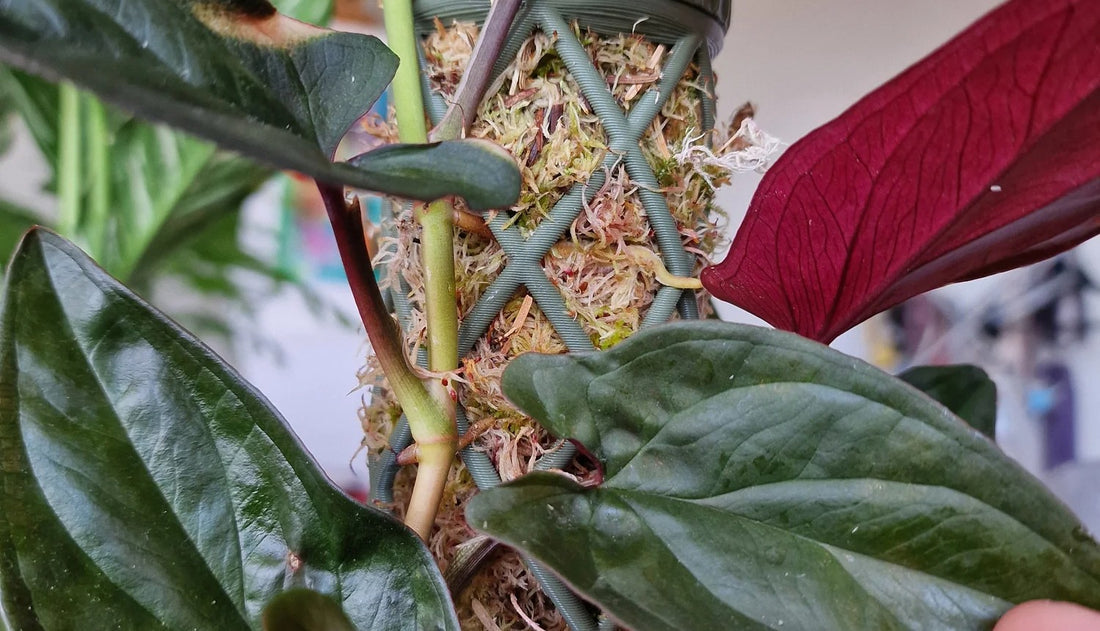
Moss pole tips - make the most of your moss pole
Share
Not sure how to use a moss pole, or considering buying one? Looking for help on how to get started as a moss pole parent? Or are you just trying to maximise the benefits of your newfound moss pole joy?
Here are some moss pole tips to get you going:
Consider the position of your moss pole inside the planter

Your moss pole does not need to sit in the dead centre of your planter! If you are working with a large root ball, or the plant is very developed with thick stems and a inflexible shape, you can choose to have the moss pole off-centre..
Try to look at your plant and root growth to help you decide where to place it, but always keep balance in mind, as the centre of gravity tends to be quite high due to the heavy hydrated moss and plant mass.
Anchoring your moss pole
You will need to anchor your moss pole in order to have a solid base, especially as you start extending your moss pole past the first couple of sections. We designed our moss pole planter for that very reason (it keeps the pole perfectly centred and perpendicular to the pot), but if you don't have one, you can always try adding some heavy stones in a thin layer at the bottom of your pot to lower the centre of gravity. Some plants don't take well to that addition to the substrate though, so use with caution. Another way to increase stability is to zip-tie the moss pole base to the bottom of the pot, ensuring it can't tip or tilt without taking the pot with it. Add this method to a heavy ceramic, concrete, or stone decorative planter, and you'll have a solid anchor for your tall moss pole.

Eventually, however, you will need to consider additional anchoring near the top of the moss pole, be it with a bracket or roof hook, because your moss pole will grow beyond the support of even the heaviest pot very soon.
Water it on a regular basis, don't let your moss dry out
The above is particularly true for moss poles that use fresh/live sphagnum moss as you are maintaining a living organism which thrives in a very humid swamp-like environment. There is almost no way to overwater this wonderful substrate, though care must be taken to prevent the excess water from accumulating in your plants substrate.
Rehydrated moss is more forgiving, and fresh moss will continue to serve its main purpose even if you let it fully dry out, though you will lose the lovely colours.
There is a watering drip cap system to our poles, but that does not mean that you can forgo frequent watering sessions. We like to mist our moss poles on the regular to keep them looking healthy!
Don't over or under pack your moss pole

As your moss pole is specifically meant to house your aerial roots, you want to ensure that oxygen, the main requirement of these roots, is abundant. You've probably noticed that putting the aerial roots of a Monstera in water will make them change colour and shape. This is because the aerial roots are not able to maintain their function, and must become water roots (which in turn will not do as well in soil or air).
Overcompacting the moss will make it difficult for the thinner aerial roots to penetrate the moss, though they may still latch on and absorb moisture. Too loosely stuffing the pole will cause it to dry out quicker, as the amount of water it can hold is directly connected to the mass of moss in the pole.
Push the moss into the sections without compressing it, just making sure there are no large pockets without moss.
Top tip: we use chopsticks to push the moss down into the sections, lightly packing the moss into the pole.
Attach plants using green tape (velcro)

We like to attach our plants to the moss poles using little strips of green gardening tape, a hook and loop material similar to velcro. This method is fully adjustable, and the material is soft so as not to damage the stems, in comparison to using wire or rope. The tape comes off as soon as the plant has latched on, but sometimes your plant needs that extra push to bring the nodes close to the moss, encouraging the aerial roots to sprout.
Get the right size
Knowing which size moss pole to get depends on the plant you have and the results you would like to see. We created a handy moss pole size guide for our products, which also has some general advice on what kinds of moss poles work for what types of plants. Too small, and the moss pole will not hold the thick aerial roots, or even bend under the weight of your plant; too large, and you'll have trouble fitting the base in the pot, and anchoring the weight down properly to prevent tipping.
Be aware that as the plant grows you might need to add moss pole extensions or even repot it. We have made our products super modular for this very reason, but even with a wire moss pole, you should be able to extend and grow using cutters and zip ties.
Know your plants
Some plants are climbing plants, putting out those aerial roots we keep mentioning, and are going to love moss poles; others will benefit from long plant pots as crawlers, and yet others will simply sit happy in your regular indoor plant pot. There is no real issue in putting a non-climbing plant on a moss pole (they will help boost humidity in the surrounding area, plus look pretty), but be realistic about the growth results you will see. If your plant is not a climber, consider using a different filling for the moss pole, such as bark which will not suffer from dehydrating, and use the sphagnum moss to top dress your pots to get the rest of the wonderful benefits it provides.
Use a good soil mix
Soil has become the most touted factor in the growth of indoor plants recently, as experts and plant enthusiasts have discovered. Where up until recently you'd just slap some potting soil from a sack you'd purchased at your local food store into your pot, now you have all the research done for you, and have the possibility to provide the perfect soil mix for your plants.
As the base root system of your plant must be nourished and cared for, don't forget to be as careful in selecting the right mix as you would be in selecting the right decorative planter for your indoor paradise.
A good soil mix might be the result of 6-7 ingredients, and buying a large amount of each, just to pot up a single plant, is just not sustainable. Luckily, our very own plant witch/doctor over at The Plant Apothecary has a wide range of mixes ready made to pot up a huge variety of plants. Here is some useful information on soil types from them.
You can rehydrate dried moss
Fresh moss can be hard to come by, so you can also rehydrate dried moss. Do this in a large clean bowl of water and then dry it slightly on a tea towel before filling the moss pole. You want the moss to be slightly moist when you fill the pole, but not dripping into the soil.



